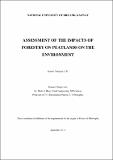| dc.description.abstract | Ireland's forest cover stands at approximately 10 %, or 700,000 ha, of the total surface area of the island and it is estimated that almost 60 % of this forestry is on peat. Forestry on peatland throughout the world is now moving towards a 'progressive management approach', which incorporates sustainable timber production alongside multiple uses such as habitat restoration, ecological regeneration and the minimisation of any potentially negative effects to the surrounding environment. However, the legacy of blanket peatland forestry, planted in the 1950s, must be dealt with, as most of this forestry is now at harvestable age and current and future recommended best management practices (BMPs) for forestry operations must consider soil and water quality, environmental impacts and greenhouse gas (GHG) emissions. The aim of this project was to investigate the short and long-term changes in nutrient and sediment releases, watertable (WT) fluctuations, and GHG emissions arising from harvesting (clearfelling) of forested peatlands in the west of Ireland.
The study was located in three sites: (1) the Altaconey (Altahoney) forest, which comprised a regenerated riparian peatland buffer clearfelled 5 years before the present study, a recently clearfelled coniferous forest, and a standing mature coniferous forest (2) a virgin peat site and (3) a paired catchment study in the Glennamong forest. The Altaconey forest was instrumented with a network of piezometers, one of which was automated, for WT and water quality measurement, a rain gauge, and open-bottomed collars for gas flux measurement. Water, soil and gas measurements, the latter of which were also collected at the VP site, were taken regularly over a 2 ¼ -year study duration (12 months before clearfelling, 15 months after). Two paired catchments in the Glennamong forest, one a study control (no clearfelling) and the other clearfelled, and each with an area of approximately 10 ha, were instrumented for water quality and flow measurement.
Management changes such as drainage, fertilisation, afforestation and subsequent clearfelling of forested peatlands influences WT position, nutrient load transfer to shallow groundwater, and GHG emissions from soil respiration. In the Altaconey forest, there was an immediate rise in the WT after clearfelling, but this had no significant impact on the concentrations of total oxidized nitrogen (TON), nitrate nitrogen (NO3--N) or dissolved reactive phosphorus (DRP), the latter of which was more impacted by degrading logging residues (brash material) than by WT fluctuations. However, fluctuations in WT did influence concentrations of ammonium-nitrogen (NH4+-N), which was highest under the standing mature coniferous forest, an area with the deepest WT. Nitrogen (N) and phosphorus (P) discharges to the adjacent watercourse in excess of maximum admissible concentrations were negligible due to the low lateral saturated conductivity and the high inherent natural attenuation capacity of the peat.
Fluctuations in the WT also affected GHG emissions from soil respiration and sequestration, as clearfelling of the forest at Altaconey produced significant increases in carbon dioxide (CO2) (11±2 kg CO2-C ha-1 d-1 before clearfelling to 19±2 kg CO2-C ha-1 d-1 after clearfelling) and methane (CH4) emissions (22±14 g CH4-C ha-1 d-1 to 163±99 g CH4-C ha-1 d-1), but a decrease in nitrous oxide (N2O) emissions (1.7 g N2O-N ha-1 d-1 to 0.7 g N2O-N ha-1 d-1).
Elevated levels of nutrients and suspended sediment (SS) in surface waters are frequently associated with forestry clearfelling operations for up to 4 years. Despite significant rises in nutrients and SS at the Glennamong study site and changes to some water parameters, the implementation of BMP, where possible, and the quick execution of a site restoration plan comprising silt traps and water management on extraction racks, appeared to negate excessive nutrients and SS export to the adjoining watercourse. | en_US |


